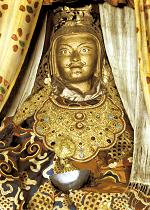Nyingma: Difference between revisions
mNo edit summary |
mNo edit summary |
||
| Line 1: | Line 1: | ||
[[Image:Guru ngadrama.JPG|frame|The famous '[[Looks Like Me]]' statue of Guru Padmasambhava]] | [[Image:Guru ngadrama.JPG|frame|The famous '[[Looks Like Me]]' statue of Guru Padmasambhava]] | ||
'''Nyingma''' [ | '''Nyingma''' ([[Wyl.]] ''rnying ma'') - the Nyingma, or Ancient school of Tibetan Buddhism is the name given to the followers of those original translations of the teachings of the Buddha into Tibetan which were carried out up until the time of the Indian translator [[Smrtijñanakirti]] in the late tenth century. They are known as the ‘Earlier Translation School ‘, Ngagyur Nyingma, distinguishing them from the ‘New Schools’, [[Sarma]], such as the [[Kadam]], [[Kagyü]], [[Sakya]], and eventually [[Geluk]], which followed the later translations made from the time of the great translator [[Rinchen Zangpo]] (958-1055) onwards. | ||
==Teachings of the Nyingma School== | ==Teachings of the Nyingma School== | ||
Revision as of 14:50, 11 July 2007

Nyingma (Wyl. rnying ma) - the Nyingma, or Ancient school of Tibetan Buddhism is the name given to the followers of those original translations of the teachings of the Buddha into Tibetan which were carried out up until the time of the Indian translator Smrtijñanakirti in the late tenth century. They are known as the ‘Earlier Translation School ‘, Ngagyur Nyingma, distinguishing them from the ‘New Schools’, Sarma, such as the Kadam, Kagyü, Sakya, and eventually Geluk, which followed the later translations made from the time of the great translator Rinchen Zangpo (958-1055) onwards.
Teachings of the Nyingma School
The Nyingma teachings are divided into the Long Transmission (Tib. ring gyü) of Kama and the Short Transmission (nyé gyü) of Terma; other teachings were received by masters directly in Pure Visions (dag nang) from deities or gurus, in experiences or in dreams.
Major Monasteries
In the Nyingma School there are two Sanghas: the monastic and yogic communities. The Nyingma tradition of Vinaya, stemming from the Budda’s son Rahula, follows the Maha-mulasarvastivadin ordination lineage, which was first brought to Tibet by Shantarakshita. The Nyingma Vinaya tradition reached its pinnacle in the eighteenth century with the reformer Dzogchen Gyalsé Shenpen Tayé, who revitalized monastic standards of discipline and scholarship.
There were more than a thousand Nyingma monasteries in Tibet, and the Nyingma tradition spread throughout the whole of Tibet and the Himalayan regions of Bhutan, Sikkim, Nepal and Ladakh. In Central Tibet, the most important were Orgyen Mindroling, built by Minling Terchen Gyurme Dorje (Terdak Lingpa) in 1676, and Tupten Dorje Drak, established by Rigdzin Ngakgi Wangpo (1580–1639) in 1610. In Kham, East Tibet, Katok was founded by Kadampa Deshek in 1159, and Palyul by Rigdzin Kunzang Sherab in 1665. In 1685 the Dzogchen monastery, destined to be the largest and one of the most influential of the Nyingma monasteries in East Tibet, was founded by Pema Rigdzin, who was the first in the line of Dzogchen Rinpoches. Shechen was founded in 1735 by the second Shechen Rabjam Rinpoche Gyurmé Kunzang Namgyal. There were also a number of Nyingma monasteries in Golok and Amdo provinces, e.g. the Dodrupchen and Tarthang monasteries.
Further Reading
- Dudjom Rinpoche, The Nyingma School of Tibetan Buddhism, Boston: Wisdom, revised edition 2002